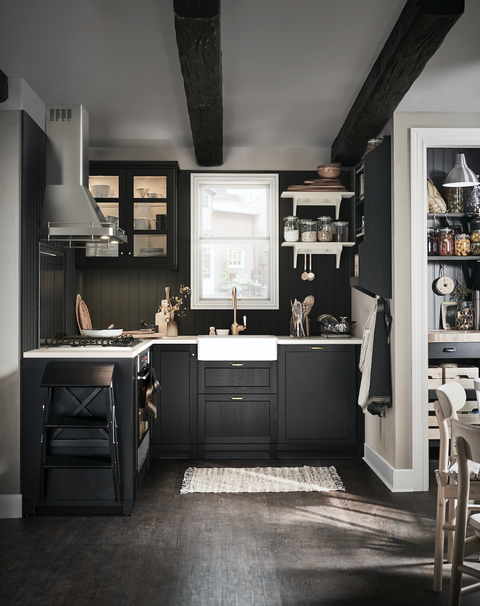Each home — and every kitchen — is unique, full of its own quirks, challenges, and charms. Since the kitchen is one of the busiest and most functional places in a house, building a system that works for you is a must.
We recently asked our Instagram followers to share their biggest questions about their most pressing kitchen wants and needs; inquiries included everything from installing islands and big storage solutions to designing a space that’s more kid friendly. Then, our friends at IKEA stepped in to offer up answers, suggestions, and more to help you infuse joy — and maybe a little order — into your kitchen.
IKEA’s Senior Interior Design Leader Viola Mushkudiani answers your most burning kitchen questions below. Make sure to follow @goodhousekeeping to keep up with stunning kitchen ideas and @ikeausa to learn how to make it all happen.
1. What’s the first thing you should do if you want to redo your kitchen?
Mushkudiani says the first thing to do is start collecting images, jotting down ideas, and selecting features you know you might want to incorporate into a new kitchen.
“Find your style,” she says. “You deserve the kitchen of your dreams, so take some time to dream a little.” She advises to use social platforms like Instagram, Pinterest, and more to begin assembling a moodboard that will help you pinpoint the colors, styles, and solutions that you are most attracted to and inspired by.
2. What’s the coolest new built-in idea for kitchens?
“Built-in appliances, such as a refrigerator, microwave, or dishwasher, create a unified look when combined with doors that coordinate with the rest of the kitchen,” Mushkudiani says.
Using cover panels for items like refrigerators and dishwashers is an easy way to streamline a kitchen’s look and feel, and it also presents order even if things are a bit wacky behind closed doors.
3. How do I make my small kitchen seem bigger while maximizing cooking and entertaining space?
There are some kitchen sizes that just can’t be changed, due to space restrictions, load-bearing walls, or budget. In such cases, Mushkudiani says, it is important to understand kitchen functions and to know what exceptions or compromises can be made — as well as what smart solutions there are to make the most use of available space.
“Use the full wall height for storage to put every inch to good use,” she explains. “Or, leave an empty space to create a more open feeling and the possibility to add other types of storage solutions, like shelving, cubbies, or pegboard. Effective interior fittings inside all cabinets and drawers maximize the use of space. Foldable, extendable, and stackable furniture keeps your layout flexible day-to-day.”
Smart usage of lighting, as well as wall, floor, and cabinet finishes will help any kitchen look bigger, and airy colors reflect light, making the room appear cool and spacious.
4. How can I tell if I’m making the most of my space when it comes to storage?
There isn’t a one-size-fits-all situation when it comes to kitchen storage (that’s just one of the reasons IKEA has so many mix-and-match options).
“Adapt the type and amount of storage to items you use, your shopping routines, and how often cooking takes place,” Mushkudiani advises. Interior fittings like racks, bins, and boxes help keep most kitchens organized and functional.
Case in point: if you cook most days, you might want extra room for food storage containers and an expansive pantry (the drawer-within-a-cabinet feature of IKEA’s SEKTION cabinets works nicely here). If you like to bake, you may need larger cabinets to store a blender, cake pans, and muffin tins. If you want to show off a collection of dishes, you may need to sacrifice storage for open shelving.
5. Does a “kitchen triangle” between the fridge, stove, and sink really make a kitchen more efficient?
The kitchen triangle helps you avoid unnecessary movement and makes you more efficient — it’s even more important to consider the activities and patterns of movement in the kitchen.
“If you place appliances and functions accordingly to create a natural workflow, it’ll save your time and energy,” says Mushkudiani.
She adds that keeping things close to where you’re likely to use them will make life in the kitchen easier. “For example, having rails and hooks to store pots, pans, utensils and gadgets; keeping plates and glasses close to the dishwasher; and spices close to the stove.”
6. How big does a kitchen need to be to have a comfortably long center island?
A kitchen island serves so many purposes: gathering place, prep area, extra storage, and more. But to use it wisely, without inhibiting how you work, there needs to be sufficient space around it.
According to Mushkudiani, you need to “ensure 47 inches between opposite kitchen combinations so that there is enough space for working and opening doors and drawers.”
Otherwise, you’ll be stuck with the possibility that an oven door won’t swing all the way open, or you’re bumping into the wall when scooting around a corner. If an island just isn’t in the cards, a cart can function in the same way without taking up too much room.
7. What’s the best way to incorporate kid’s items into the kitchen?
“In the kitchen, children want to be a part of the action — it’s one of their ways of learning,” says Mushkudiani. That means that the kitchen should be inviting, yet safe, for kids. Here are four ways to get them excited about everyday tasks:
- Give them their own storage. Store toys and other children’s things in a base cabinet so that they can reach them easily.
- Let your children join in cooking activities by using child-friendly kitchen utensils.
- Step stools are useful for children who want to see and be a part of the action in the kitchen.
- Any play area needs to be placed away from the cooking area so that it does not obstruct the natural workflow in the kitchen.
8. I have three young sons. How do I maintain uncluttered minimalism?
Mushkudiani says that “the more organized the storage, the more comfortable the whole family will be.” Even when you’ve smartly laid out a base layer of cabinets, it’s important to think about what goes inside of them, too, to put organization front and center. (Opt for solid fronts here to keep things behind closed doors.)
As mentioned in question 7, Mushkudiani says that if your children “help” you cook, make sure they have a specific place from which to grab and return their things, like a bin or basket. “Keeping children’s toys within reach means they can choose their own play activities and, at the same time, learn to put them away when play is over,” she adds.
9. How do you brighten up a kitchen that has no windows?
Lighting is one of the best ways to alter a kitchen’s atmosphere. Smart placement in layers balances general ambience with safe, task-specific work.
“Kitchens need general lighting, such as ceiling lamps, that spread light evenly throughout the whole room,” Mushkudiani explains. “To make work easier and to minimize the risk of accidents, kitchens also need task lighting for specific areas.”
Integrating lighting inside kitchen drawers and lights above cabinets will offer additional sources of illumination, making it easier to see what is stored in any given part of the kitchen.
If the kitchen has no natural light, she adds, try to use lighter colors for your fronts, as well as the wall and floor finishes, to reflect the light.
10. How do you hide all the appliances — bread maker, stand mixer, etc. — without a butler pantry?
There’s no need for a butler pantry when you can integrate its functions — a staging area for meals and extra storage — into your kitchen in other ways.
“Utilize base or corner cabinets with flexible interior fittings, such as adjustable or pull-out to store your appliances,” says Mushkudiani. (This helps save space in cabinets and drawers, making everything organized and reachable.) “Large kitchen carts can also help you organize appliances. They provide easy access to gadgets and give you an extra work surface.”
For more kitchen design inspiration and tips, visit IKEA-USA.com/kitchens.
Source: Home Ideas - goodhousekeeping.com






